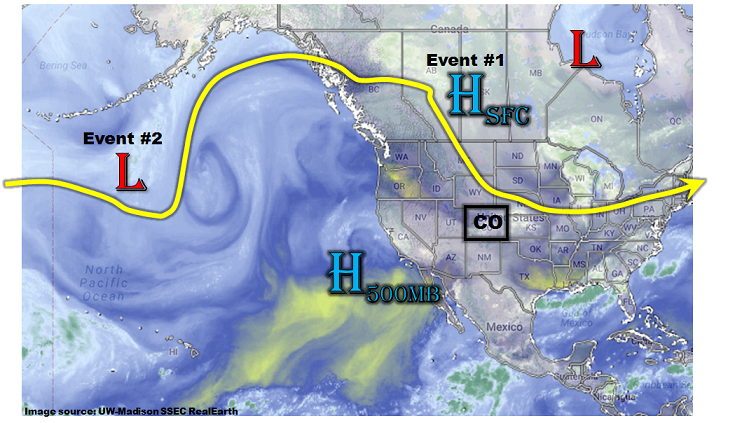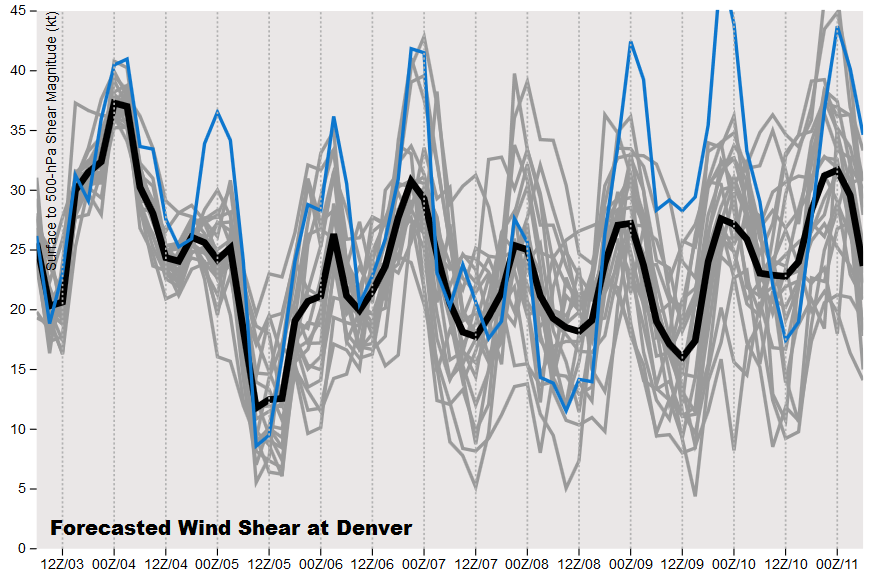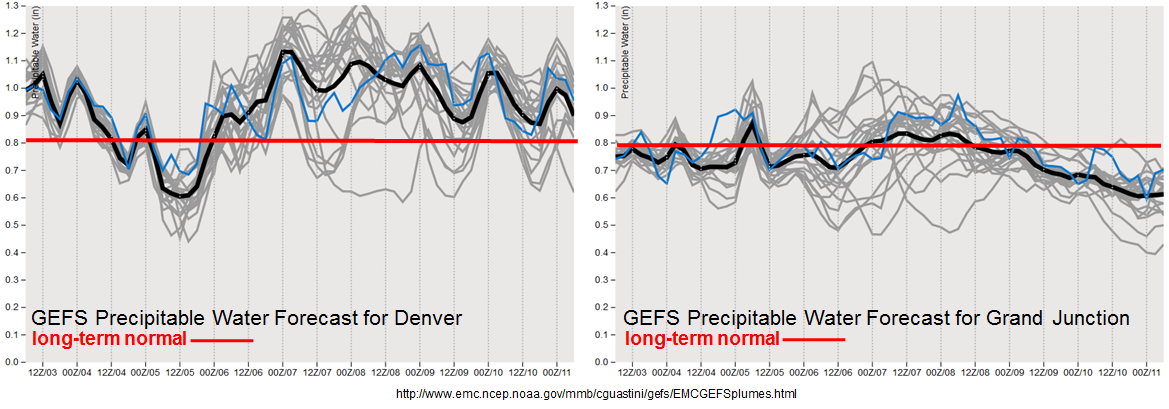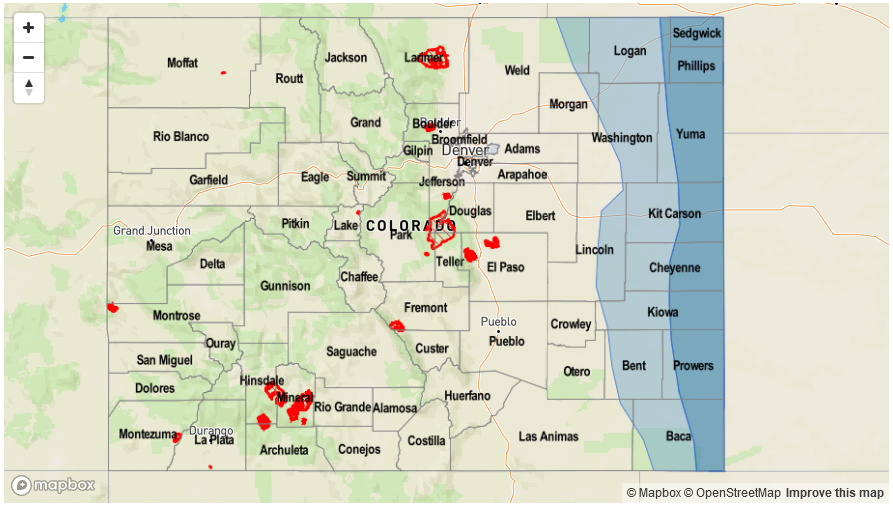Issue Date: Thursday, August 3, 2017
Issue Time: 1PM MDT
Valid Dates: 8/4-8/18
 Changes have been, and will continue to be in Colorado’s air for this edition of the 15-day Flood Threat Outlook. As shown in this morning’s water vapor image, below, an upper-level trough has established itself over the northern Great Plains. This has allowed for cool air out of Canada to be transported into eastern Colorado. For example, today’s high temperatures are up to 20F below normal in the northeast part of the state.
Changes have been, and will continue to be in Colorado’s air for this edition of the 15-day Flood Threat Outlook. As shown in this morning’s water vapor image, below, an upper-level trough has established itself over the northern Great Plains. This has allowed for cool air out of Canada to be transported into eastern Colorado. For example, today’s high temperatures are up to 20F below normal in the northeast part of the state.
As shown in the 500mb GFS ensemble forecast maps, below, this trough is expected to persist not just in the short-term but possibly for the next 7 or more days. Meanwhile, Precipitable Water, while lower today than last week’s impressive string of elevated levels, remains above average. The positioning of the Great Plains trough will allow for a slew of mid-level disturbances to enter Colorado, especially the northeast quadrant of the state. In addition, many of these disturbances will be followed by weak to moderate strength surface high pressure systems such as the one currently moving southward. With some degree of elevated moisture remaining in the state, we foresee a prolonged period of active weather, mainly east of the Continental Divide.
Although active weather is expected, instability will not be as much of a given as in the past few weeks especially in northeast Colorado. Another important wildcard is that Great Plains trough will keep strong mid and upper-level winds around. For example, below is the forecast for the surface to 500-mb wind shear (keep in mind, this value can only be positive) at Denver. For reference, the average value for this time of year is about 15 – 18 knots. Instead, what we see is consistently strong shear with many days approaching or exceeding 30 knots. As some of you weather gurus know, there is only one implication of this in the summer: severe weather. Strong shear promotes tilted, possibly rotating storm updrafts that in turn support large hail and the transfer of momentum from the high mid-level wind speeds down to the surface. Thus, we foresee that severe weather will be a frequent component of eastern Colorado’s forecast for the next week.
Finally, most of the discussion has focused on eastern Colorado. Given that we are right in the middle of monsoon season, it would be amiss to not discuss the western slope. As shown below, while Denver’s PW will remain elevated for the next 7+ days, Grand Junction (and most of the western slope) will be near average to below average. The positioning of the upper-level ridge over the southwest US is not particularly conducive for moisture transport into western Colorado. Thus, although some isolated moderate to heavy rainfall will be possible especially over the shorter term, we expect drier than normal weather overall.
We have identified two precipitation events for this Outlook, which are described in more detail below.
Event #1: Friday (8/4) through Wednesday (8/9)
Elevated Flood Threat for daily rounds of heavy rainfall over mainly eastern Colorado
The combination of passing mid-level shortwaves and a one or more surface high pressure systems will allow for a very active weather pattern, especially in eastern Colorado. While the far northeast part of the state will experience very cool conditions, farther south, expect diurnal upslope flow to result in scattered to numerous showers and thunderstorms that will quickly move off the mountains and into the eastern plains. Over the next 5 days, widespread rainfall above 1 inch is likely. However, many locations will receive much more than that, with up to 4 or 5 inches not out of the question. On a daily level, max 1-hour rainfall up to 2.1 inches (east) and 1.4 inches (west) will be possible though 3 hour rainfall up to 3 inches could also occur. Severe weather will be possible nearly every day from Friday through Wednesday. Large hail will be the primary threat, with gusty winds also possible.
The main impacts from this event will be isolated flash flooding, higher elevation mud flows and debris slides (especially over fire burns) and street flooding in urban areas. However, we are also becoming increasingly concerned about riverine flooding within the Arkansas River basin where the past 30 days have seen near record rainfall over a wide area. Current flows from the headwaters downstream to the Kansas border are in the 75th to 90+ percentiles. The riverine flooding threat will increase as this event wears on. Please check back for Monday’s Outlook as well as daily Flood Threat Bulletins for the latest information.
Event #2: Thursday (8/10) through Saturday (8/12)
No Apparent Flood Threat for isolated heavy rainfall in far eastern parts of the state
Drier air will eventually encroach on Colorado from the northwest, which will reduce heavy rainfall potential following Event #1. However, with the Great Plains trough expected to stay in place, return flow could provide adequate moisture for isolated heavy rainfall in far eastern areas. In addition, the severe weather chances are likely to stay elevated. Currently, it is unclear if the flood threat will be within Colorado’s border, hence why this event is not assigned a threat yet.






